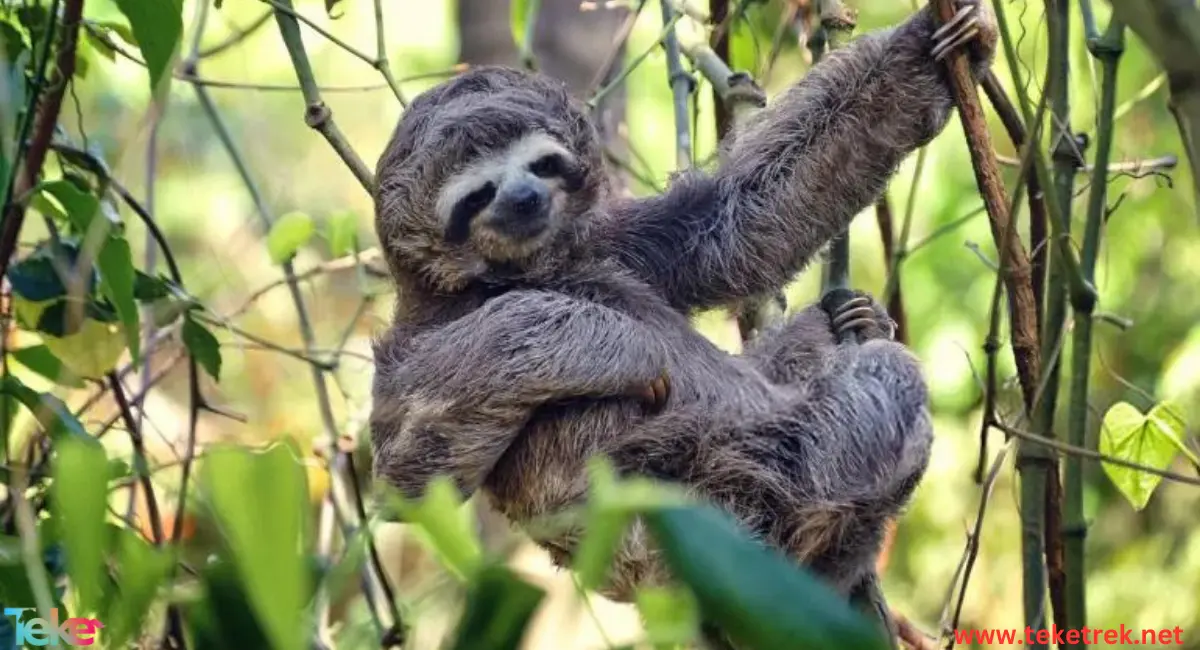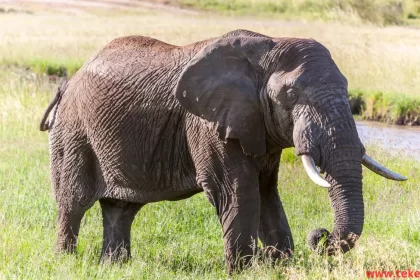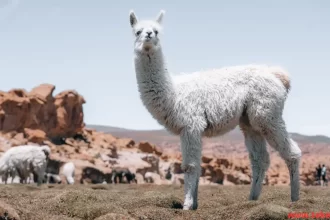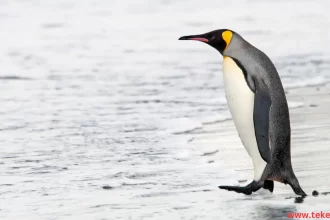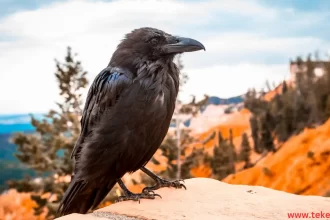Sloths are known for their slow movement, not because they’re lazy but because they simply move slowly. Sloths are the slowest mammals. In this article from teketrek, we’ll talk about sloths, their lifestyle, diet, and habitats.
The giant Sloths appearance
Sloths have a thick fur coat that is brown, black, or gray in color. Their fur often has layers of algae.
Sloths are about the size of a cat, with a length of around 60 cm. They have a short, flat head, large eyes, a short or absent tail, long legs, small ears, and strong curved claws on each foot.
Sloths use their claws to cling to trees, which is their only defensive mechanism. When threatened, a cornered sloth may swipe its claws to scare or injure attackers.
Sloths have excellent camouflage in trees and move slowly, avoiding attention. They are vulnerable only during their rare visits to ground level.
Some sloths have colonies of green algae covering their fur, enhancing camouflage and providing some nutrients. Sloths lick the algae while grooming.
The fur of sloths serves specialized functions, growing in the opposite direction of other mammals.
Most mammals have hair growing towards their extremities, but because these animals spend long periods with their legs above their bodies, their hair grows away from the extremities to provide protection.
Sloths are quadrupedal animals that walk upside down along tree branches. They rarely venture to descend to the ground and walk upright, and they are proficient swimmers.
Sloths have made unusual adjustments to arboreal lifestyle.
Sloths have a very large, specialized, slow-acting, multi-compartmental stomach where symbiotic bacteria (living together with different organisms) break down tough leaves.

Sloth Diet: What do sloths eat?
Sloths are believed to be herbivores, but some accounts suggest they are carnivorous animals. They may consume insects, small lizards, and carrion, but their diet primarily consists of buds and leaves, including leaves from the Cecropia tree.
Initially thought to consume Cecropia leaves because they were often observed in Cecropia trees, sloths have been found to inhabit many other trees as well. However, they are not as easily spotted there as in Cecropia trees.
Sloths have a slow metabolism and low body temperature, keeping their food and water needs to a minimum. They have small molars used for chewing their fibrous food. Their stomach has many separate parts used in digesting tough cellulose, a component of the plant material they eat.
Sloths habitat: Which country do sloths live in?
Sloths inhabit tropical and subtropical regions of South and Central America, including Brazil, Peru, Belize, Guatemala, Colombia, Venezuela, and others. They live in the high branches of tropical rainforest. It spends its life hanging upside down on tree branches. ts and it lives his life hanging from tree branches..se wooded areas where they find the leaves and fruits they feed on. Sloths prefer staying in the canopy to protect themselves from predators.
Sloth Behavior:
Sloths spend most of their lives hanging upside down from tree branches. They eat, sleep, mate, and give birth while hanging upside down in trees. Sloths grip tree branches with strong curved claws on each of their four feet. Male sloths are solitary and shy, while females sometimes gather together. They are nocturnal animals, being most active at night and sleeping throughout the day, hanging upside down.
It moves very slowly and only when necessary. They have about half the amount of muscle tissue found in other animals of similar weight. They can move a little faster if they are in direct danger from a predator, but doing so burns large amounts of energy. Sometimes, sloths remain hanging on branches after death. Sloths particularly tend to nest in the crowns of palm trees where they can camouflage as coconuts. They come down to the ground to urinate and defecate only once a week.
Reproduction of Sloths:
Sloths typically live for 10 to 20 years in the wild. Adult females produce one offspring each year, but sometimes lack of mobility can prevent females from finding males for over a year. They also give birth while hanging upside down from a tree branch.
Sloth infants usually cling to their mothers’ fur, but occasionally they fall. Thanks to their extremely strong structure, they often survive falls and rarely die from them. In some cases, they may die indirectly from falls because mothers are reluctant to leave the safety of the trees to retrieve their young.
Predators of Sloths:
The main predators of sloths include jaguars, harpy eagles, and humans. The majority of sloth deaths in Costa Rica are due to contact with power lines and from illegal hunting.
Their claws also provide another unexpected deterrent to human hunters. When hanging upside down in a tree, they are anchored in place by their own claws and often do not fall even if shot from below.
The primary forms of protection for sloths are camouflage (which is greatly enhanced by the layer of algae that grows on their fur) and their extremely slow movement.
Sloth Species:
Three-toed Sloth:
Exclusive to Isla Escudo de Veraguas off the coast of Panama, the Three-toed Sloth is one of the smallest sloth species and is critically endangered. It has a slightly spotted back and is often greenish due to algae living in its fur.
Maned Sloth:
Found in the Atlantic coastal rainforests of southeastern Brazil, this species is distinguished by long black hair on its neck and shoulders, particularly prominent in males.
Pale-throated Sloth:
The Pale-throated Sloth is a three-toed sloth species found in tropical forests in northern South America. It is present in regions such as Guyana, French Guiana, Suriname, Brazil, and Venezuela. Individuals of both sexes have a dark gray color with dark patches.
Brown-throated Sloth:
It is the most widespread and common species, found from Honduras in Central America to northern Argentina in South America. As its name suggests, its throat is brown, and its fur can vary in shade from gray to brown depending on location and age.

Questions and answers about Sloths:
- Are sloths friendly to humans or dangerous?
Sloths are generally gentle and not aggressive towards humans, but they are wild animals and should be treated with caution and respect.
- Is A sloth a Bear or a Monkey?
A sloth is neither a bear nor a monkey. It belongs to the order Pilosa and the suborder Folivora, making it closely related to anteaters and armadillos.
- What does a sloth do?
Sloths are primarily known for their slow movement and spend most of their time hanging upside down in trees. Sloths have a low metabolism and sleep for long periods, up to 15-20 hours a day. They are solitary animals and are well-adapted to their arboreal habitat.
- How long do sloths live?
Sloths typically live for about 10 to 20 years in the wild, depending on the species and various environmental factors.
- What is the laziest sloth in the world?
The three-toed sloth (Bradypus tridactylus) is considered the laziest among sloth species. It spends most of its time sleeping in the treetops and moves very slowly when it needs to find food or fulfill its basic needs.
- Why is a sloth called a sloth?
The name “sloth” is believed to come from its calm nature and slow movements. It moves extremely slowly and always appears unhurried or leisurely in its actions, resembling the traits of laziness and lethargy.
- Why don’t sloths get sick?
Sloths rarely suffer from significant diseases due to their balanced diet, low activity level, low body temperature, and genetic adaptation.
- How long does a sloth sleep?
A sloth lives for an hour
- Why does a sloth move so slowly?
Because it lives in trees so it doesn’t have to run away from predators.
In conclusion, despite their inability to survive outside the lush rainforests of South and Central America, sloths are remarkably successful creatures within that environment. They can represent up to half of the total energy consumption and two-thirds of the total biomass of terrestrial mammals in some areas.
Among the six species, only one, the Three-toed Sloth, is currently classified as “critically endangered.” However, ongoing destruction of South American forests may soon pose a threat to others.
Sources:

